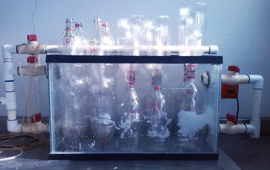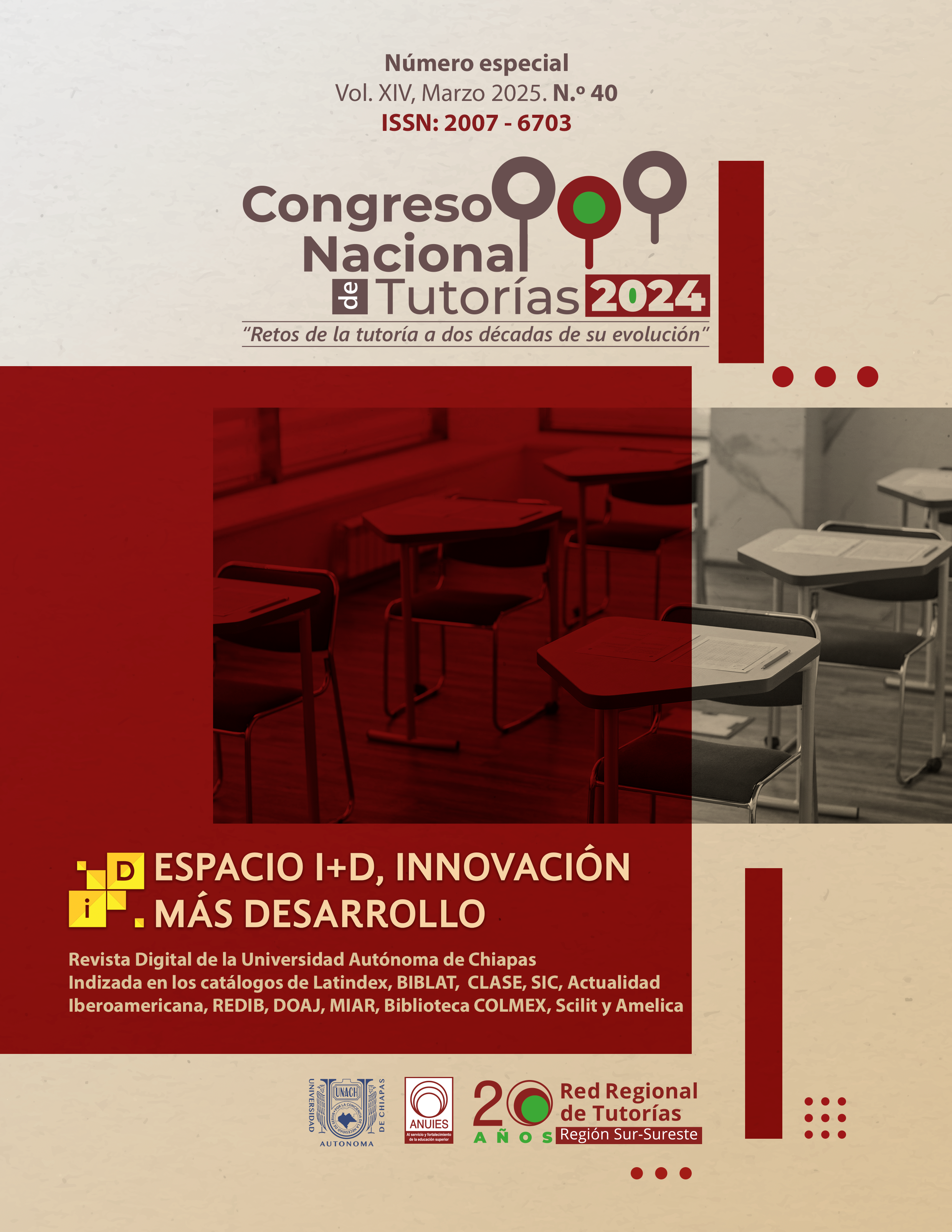Reactor aerobio con medio de soporte fijo utilizando botellas de Pet
DOI:
https://doi.org/10.31644/IMASD.12.2016.a07Palabras clave:
Biopelícula, Tratamiento de aguas domésticas, Polientileno tereftalatoResumen
El tratamiento de aguas residuales, ha sido utilizado en muchas partes del mundo con diferentes sistemas de depuración de contaminantes. Sin embargo se ha comprobado que muchos de estos contaminantes representan un peligro para la salud del hombre y seres vivos. Debido a lo anterior el objetivo de esta investigación fue implementar un reactor biológico rectangular de 90 litros de capacidad, aireado y conteniendo en su interior botellas plásticas de PET (polietileno tereftalato) como medio de soporte para la producción de una biopelícula para el tratamiento de aguas residuales domésticas. Durante el experimento se monitoreó el influente y efluente donde se obtuvo una remoción de la Demanda Bioquímica de Oxigeno (DBO5) de 97.6% y Demanda Química de Oxígeno (DQO) de 97.7%, como parámetros indicadores de la calidad del agua residual tratada con un tiempo promedio de tratamiento de 2.72 horas.
Descargas
Citas
Adler I. (1987) Proc. lnt Eur. Congr. on Biotechnology, Vol. 1, p. 1. Amsterdam. The Netherlands.
Atkinson B. (1975). Biochemical Reactors. Pion Press, London.
Bassin JP, KleerebezemR, Rosado AS, Van Loosdrecht MCM, Dezotti M (2012). Effect of different operational conditions on biofilm development, nitrification, and nitrifying microbial population inmoving bed biofilm reactors. Environ Sci Technol 46:1546-1555.
Battin TJ, Sloan WT, Kjelleberg S, Daims H, Head IM, Curtis TP, Eberl L. (2007). Microbial landscapes: new paths to biofilm research. Nat Rev Microbiol 5:76-81.
Castro, F. D., Bassin, J. P., & Dezotti, M. (2016). Treatment of a simulated textile wastewater containing the Reactive Orange 16 azo dye by a combination of ozonation and moving-bed biofilm reactor: evaluating the performance, toxicity, and oxidation by-products. Environmental Science and Pollution Research, 1-10.
Dong B, Chen H, Yang Y, He Q, Dai X (2014). Treatment of printing and dyeing wastewater using MBBR followed by membrane separation process. Desalin Water Treat 52:4562-4567.
Dvořák L, Lederer T, Jirků V, Masák J, Novák L (2014). Removal of aniline, cyanides and diphenylguanidine from industrial wastewater using a full-scale moving bed biofilm reactor. Process Biochem 49: 102-109.
Gu, Q., Sun, T., Wu, G., Li, M., & Qiu, W. (2014). Influence of carrier filling ratio on the performance of moving bed biofilm reactor in treating coking wastewater. Bioresource technology, 166, 72-78.
Hayden K. Webb, Russell J. Crawford, Tomoo Sawabe, and Elena P. Ivanova. (2008). Poly (ethylene terephthalate) Polymer Surfaces as a Substrate for Bacterial Attachment and Biofilm Formation. Microbes and Enviromental, 24, 40-42.
Hibiya K, Nagai J, Tsuneda S, Hirata, A. (2004). Simple prediction of oxygen penetration depth in biofilms for wastewater treatment. Biochem Eng J 19:61-68.
Hu, X. B., Xu, K., Wang, Z., Ding, L. L., & Ren, H. Q. (2013). Characteristics of biofilm attaching to carriers in moving bed biofilm reactor used to treat vitamin C wastewater. 35(5), 283-291.
Jorgensen H, Morkeberg A, Krogh KBR, Olsson L. (2004). Growth and enzyme production by three Penicillium species on monosaccharides. J Biotechnol 109:295-299.
Kishu Phaugat, Manu Bhambi, Renu, C.S. Pundir. (2009). Polyethylene terephthalate membrane as a support for covalent immobilization of uricase and its application in serum urate determination. Journal of Molecular Catalysis B: Enzymati, 62, 28-30.
McNaught, H., & Wert, E. C. (2015). Evaluation of Chemical and Environmental Methods to Optimize Performance of Fixed Bed Biofilm Reactors to Remove Ozonation By-Products. Ozone: Science & Engineering, 37(3), 227-239.
Mohan SV, Reddy CN, Kumar AN, Modestra JA (2013). Relative performance of biofilm configuration over suspended growth operation on azo dye based wastewater treatment in periodic discontinuous batch mode operation. Bioresour Technol 147:424-433.
Morgenroth E, Milferstedt K. (2009). Biofilm engineering: linking biofilm development at different length and time scales. Rev Environ Sci Biotechnol 21:3203-3208.
Osorio, F., Hontoria, E., (2001). Optimization of bed material height in a submerged biological aerated filter. J. Environ. Eng. 127, 974-978.
Park HO, Oh S, Bade R, Shin WS (2010). Application of A2O moving bed biofilm reactors for textile dyeing wastewater treatment. Korean J Chem Eng 27:893-899.
Remoundaki E, Kousi P, Joulian C, Brunet FB, Hatzikioseyian A, Tsezos M. (2008). Characterization, morphology and composition of biofilm and precipitates from a sulphate-reducing fixed-bed reactor. J Hazard Mater 153:514-524.
Rusten B, Eikebrokk BJ, Ulgenes Y, Lygren E. (2006). Design and operations of the Kaldnes moving bed biofilm reactors. Aquacult Eng 34:322-331.
Tansel B, Sager J, Garland J, Xu SH, Levine L, Bisbee P. (2006). Deposition of extracellular polymeric substances (EPS) and microtopographical changes on membrane surfaces during intermittent filtration conditions. J Membr Sci 285:225-231.
Tóthy Szilágyi, (2013). "Full scale application of an FBAS technology -a case study". 9th International Conference on Biofilm Reactors. Paris, Francia.
Utgikar VP, Harmon SM, Chaudhary N, Tabak HH, Govind R, Haines JR. (2002). Inhibition of sulfate-reducing bacteria by metal sulfide formation in bioremediation of acid mine drainage. Environ Toxicol 17:40-48.
Vendramel, S., Bassin, J. P., Dezotti, M., & Sant'Anna Jr, G. L. (2015). Treatment of petroleum refinery wastewater containing heavily polluting substances in an aerobic submerged fixed-bed reactor. Environmental technology, 36(16), 2052-2059.
Wang XJ, Xia SQ, Chen L, Zhao JF, Renault NJ, Chovelon JM. (2006). Nutrients removal from municipal wastewater by chemical precipitation in a moving bed biofilm reactor. Process Biochem 41:824-828.
Yan DZ, Bai ZH, Gu R, Mike LK, Ren SM, Yang PL. (2009). Biofilm structure and its influence on clogging in drip irrigation emitters distributing reclaimed wastewater. J Environ Sci 21:834-841.
Yang, Z. Z., Yang, Z. M., Cao, J. G., Jia, Y. Y., & Xu, J. X. (2013). Study on the Combination of Fixed Bed and Moving Bed Biofilm Reactor for Papermaking Terminal Wastewater Treatment. In Advanced Materials Research (Vol. 777, pp. 309-313). Trans Tech Publications.
Zhan XM, Michael R, O’Reilly Edmond. (2006). Biofilm growth and characteristics in an alternating pumped sequencing batch biofilm reactor (APSBBR). Water Res 40:817- 825.
ZoBell C. E. (1943). The effect of solid surfaces upon bacterial activity. J. Bact. 46, 39 56.
























